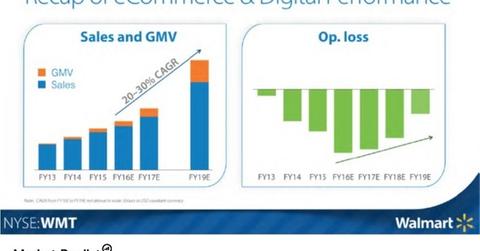Inherent Risks and Rewards in Walmart’s E-Commerce Business
Walmart’s (WMT) e-commerce business is slated to grow the fastest of all its channels, at 20%–30% per annum from fiscal 2016 to fiscal 2019. E-commerce sales were $12.2 billion in fiscal 2015, a growth rate of 22%.
Oct. 21 2015, Updated 8:05 p.m. ET

Walmart provides e-commerce update at 22nd Annual Meeting for the Investment Community
Walmart’s (WMT) e-commerce business is slated to grow the fastest of all its channels, at 20%–30% per annum from fiscal 2016 to fiscal 2019. Walmart clocked $12.2 billion in e-commerce sales in fiscal 2015, a growth rate of 22% year-over-year.
According to C. Doug McMillon, Walmart’s CEO (chief executive officer), the company is among the three largest online retailers in terms of web traffic, with the Walmart US app in the “top three apps in retail.”
Market expansion
Over the next three years, Walmart is looking to scale up its online presence in more markets and increase its product assortment. It has already introduced grocery pickup service in 20 US markets and hopes to operate the model in another 20 markets next year.
The company reported a significant increase in pickup traffic from its neighborhood store formats this year, according to comments by Greg Foran, president and chief executive officer of Walmart US.
Product assortment
Walmart’s availability of products online is also increasing exponentially. The company has 7 million products currently available on its website and plans to take the number to 10 million by the end of the year. In the future, product availability is expected to number in the tens of millions, according to Neil Ashe, CEO of Global e-Commerce, Walmart.
Walmart’s also looking to introduce a marketplace model in the future. It’s also testing the unlimited Shipping Pass program, a competitor to Amazon Prime (AMZN).
Bottom-line impact
While these initiatives are certainly beneficial to Walmart’s top line, their impact is less discernible on profitability. Margins in the grocery business are notoriously thin. Coupled with the high costs initially associated with investments in digital and distribution, Walmart anticipates that its e-commerce business will stay unprofitable until at least fiscal 2019, although the losses are expected to progressively decline.
Online players like Amazon (AMZN) and JD.com (JD) have been earning low margins. Walmart’s operating income margin in the trailing 12 months came in at 5.4% compared to 3.2% for Kroger (KR), 0.8% for Amazon, and -1.9% for JD.com.
Walmart, Amazon, and Kroger together make up 1.9% of the portfolio holdings of the SPDR S&P 500 ETF (SPY).
